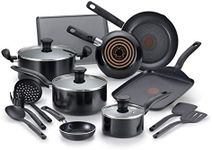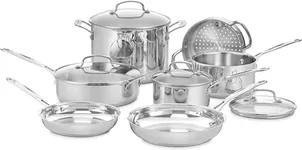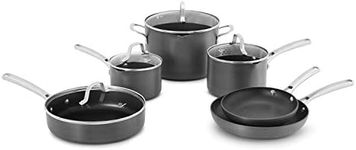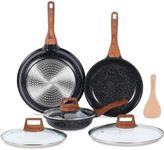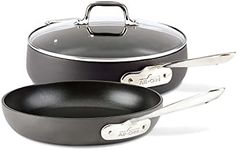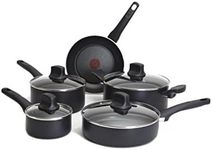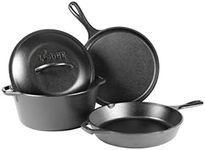Buying Guide for the Best Pan Set For Gas Stove
Choosing the right pan set for a gas stove can make a big difference in your cooking experience. Gas stoves heat up quickly and provide direct, adjustable flames, so you want pans that can handle rapid temperature changes and distribute heat evenly. When shopping for a pan set, it's important to consider the materials, construction, and features that will work best with your cooking style and the types of dishes you prepare most often. Understanding the key specifications will help you select a set that is durable, easy to use, and delivers great results on your gas stove.MaterialThe material of the pans affects how well they conduct and retain heat, as well as their durability and ease of cleaning. Common materials include stainless steel, aluminum, copper, and cast iron. Stainless steel is durable and resistant to rust, but may not heat as evenly unless it has an aluminum or copper core. Aluminum heats quickly and evenly, but can warp over time unless it's hard-anodized. Copper offers excellent heat control but usually comes with a stainless steel lining for safety. Cast iron retains heat well and is great for searing, but is heavy and requires seasoning. If you cook a variety of dishes and want easy maintenance, stainless steel with an aluminum core is a good all-rounder. For high-heat searing or slow cooking, cast iron might be your best bet.
Base ThicknessThe thickness of the pan's base determines how evenly it heats and how well it resists warping on a gas flame. Thin bases can heat up quickly but may develop hot spots and warp over time, while thicker bases distribute heat more evenly and are more durable. For most home cooks, a medium to thick base is ideal, as it balances quick heating with even cooking. If you often cook delicate sauces or foods that require precise temperature control, opt for pans with a thicker, multi-layered base.
Nonstick CoatingNonstick coatings make pans easier to clean and reduce the need for oil, which is helpful for low-fat cooking. However, nonstick surfaces can wear out over time, especially with high heat or metal utensils. If you frequently cook eggs, pancakes, or other sticky foods, a nonstick pan is convenient. For high-heat cooking or browning, traditional metal surfaces like stainless steel or cast iron are better, as they can handle higher temperatures without damage.
Handle DesignHandles affect how comfortable and safe the pans are to use, especially when moving them on and off a gas stove. Look for handles that stay cool to the touch and are securely riveted or welded to the pan. Some handles are designed with ergonomic shapes for a better grip. If you often transfer pans from stove to oven, make sure the handles are oven-safe. Choose a handle style that feels comfortable in your hand and suits your cooking habits.
Lid Fit and MaterialLids help retain heat and moisture while cooking. A well-fitting lid prevents steam from escaping, which is important for simmering and braising. Lids can be made of metal or glass; glass lids let you monitor food without lifting the lid, but can be heavier and more fragile. If you like to keep an eye on your food, glass lids are useful. For durability and lighter weight, metal lids are a good choice.
Set CompositionPan sets come in various combinations of fry pans, saucepans, stockpots, and more. Consider what types of cooking you do most often. If you mainly fry and sauté, look for sets with multiple frying pans. If you make soups and stews, a set with a large stockpot is helpful. Think about your typical meals and choose a set that includes the pieces you'll use most, rather than just going for the largest set available.

